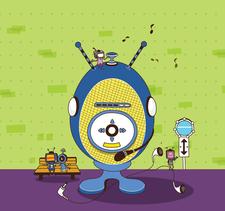Digital audio workstation Tracktion T6 at a glance
Fast and Fluid

The Tracktion digital audio workstation is finally taking off as it reaches version 6.
Musicians have a growing number of options in the Linux ecosystem. Some well-established digital audio workstation (DAW) suites, such as Ardour or Qtractor – and several hundred effects and instruments – are available under a free license. However, proprietary software is also increasingly making its way into the market. One example is Tracktion T6, a low-budget DAW. Version 6 of Tracktion has been officially available for Linux since the summer (Figure 1).
 Figure 1: New tracks for automation, new step-sequencer clips, new MIDI functions, and improved system integration make Tracktion 6 an interesting product for musicians using Linux.
Figure 1: New tracks for automation, new step-sequencer clips, new MIDI functions, and improved system integration make Tracktion 6 an interesting product for musicians using Linux.
Just like Home
The Tracktion Software Company [1] has offered the program for Linux since 2013. The software was essentially designed as a Windows program, but uses Juce (see "The Juce Library" box) for its audio engine and interface. Juice author Julian Storer is active in the Linux audio scene and has published a wide range of plugins and tools for Linux musicians under free licenses.
[...]
Buy this article as PDF
(incl. VAT)
Buy Linux Magazine
Subscribe to our Linux Newsletters
Find Linux and Open Source Jobs
Subscribe to our ADMIN Newsletters
Support Our Work
Linux Magazine content is made possible with support from readers like you. Please consider contributing when you’ve found an article to be beneficial.

News
-
Manjaro 26.0 Primary Desktop Environments Default to Wayland
If you want to stick with X.Org, you'll be limited to the desktop environments you can choose.
-
Mozilla Plans to AI-ify Firefox
With a new CEO in control, Mozilla is doubling down on a strategy of trust, all the while leaning into AI.
-
Gnome Says No to AI-Generated Extensions
If you're a developer wanting to create a new Gnome extension, you'd best set aside that AI code generator, because the extension team will have none of that.
-
Parrot OS Switches to KDE Plasma Desktop
Yet another distro is making the move to the KDE Plasma desktop.
-
TUXEDO Announces Gemini 17
TUXEDO Computers has released the fourth generation of its Gemini laptop with plenty of updates.
-
Two New Distros Adopt Enlightenment
MX Moksha and AV Linux 25 join ranks with Bodhi Linux and embrace the Enlightenment desktop.
-
Solus Linux 4.8 Removes Python 2
Solus Linux 4.8 has been released with the latest Linux kernel, updated desktops, and a key removal.
-
Zorin OS 18 Hits over a Million Downloads
If you doubt Linux isn't gaining popularity, you only have to look at Zorin OS's download numbers.
-
TUXEDO Computers Scraps Snapdragon X1E-Based Laptop
Due to issues with a Snapdragon CPU, TUXEDO Computers has cancelled its plans to release a laptop based on this elite hardware.
-
Debian Unleashes Debian Libre Live
Debian Libre Live keeps your machine free of proprietary software.

